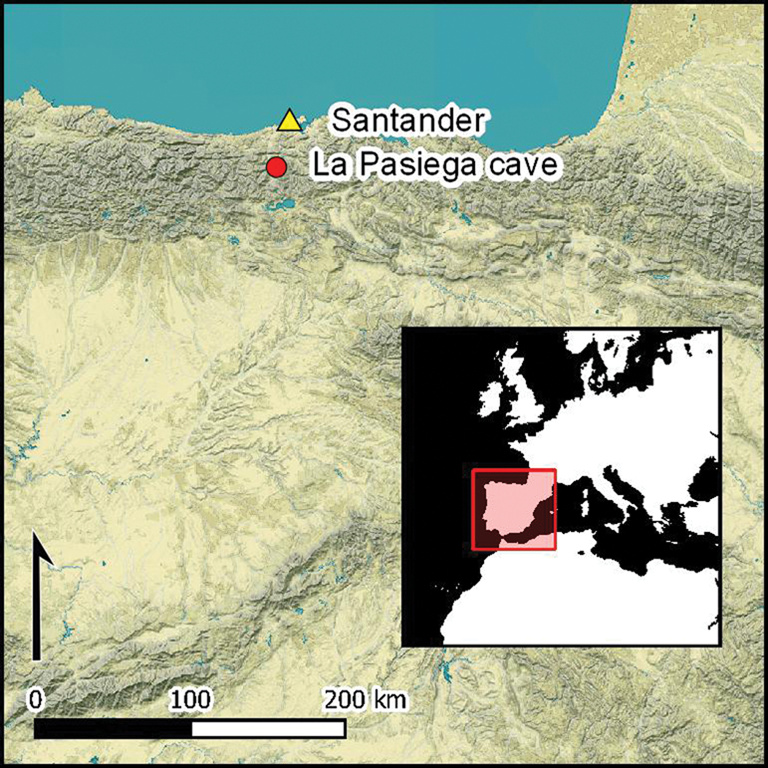
Introduction
Cantabria in northern Spain has more than 100 examples of caves with parietal art dating from the Early Upper Palaeolithic through to the Last Upper Palaeolithic period (González Sáinz Reference González-Echegaray2004; Ontañon et al. Reference Ontañón, Bayarri, Castillo, Montes, Morlote, Muñoz and Palacio2019). Recent studies have now extended the known chronology of cave art in this region back to the Middle Palaeolithic (Hoffmann et al. Reference Hoffmann2018, but see Slimak et al. Reference Slimak, Fietzke, Jean-Michel and Ontañon2018 and reply by Hoffmann et al. Reference Hoffmann2020). The Cantabrian artistic corpus includes zoomorphic and anthropomorphic figures, negative and positive hands and a variety of signs, dots, finger marks and isolated strokes. In addition, there are many examples in this karst region for the intentional incorporation of rock formations into artistic expressions. These include ‘masks’ incorporating anatomical parts (e.g. eyes or nostrils) painted in black charcoal on rock protrusions at Castillo, La Garma and Altamira; the bird of La Pasiega (Gallery B), where a natural protuberance of the wall was modified by adding an eye, feet and beak in red pigment; and the modification of a stalagmite formation at Castillo to form a bison (Groenen & Clottes Reference Groenen and Clottes2016). This practice is also evident at Altamira, where a group of painted and engraved bison make use of geological formations on the cave ceiling (Aranburu & Iriarte Reference Aranburu, Iriarte, Gárate Maidagan and Unzueta2017).
It is only in the past few decades that scholars have considered the incorporation of such natural rock formations into cave art (Lorblanchet Reference Lorblanchet1993; Saura et al. Reference Saura Ramos, Pérez-Seoane, De Quirós, Lasheras Corruchaga and Beltrán1998; Sauvet & Tosello Reference Sauvet, Tosello, Sacco and Sauvet1998; Múzquiz & Saura Reference Múzquiz Pérez-Seoane, Saura and Lasheras2002; Brot Reference Brot2010; Ogawa Reference Ogawa and Clottes2010; Fritz et al. Reference Fritz, Willis and Tosello2016; Groenen & Clottes Reference Groenen and Clottes2016; Sakamoto et al. Reference Sakamoto, Pettitt and Ontañon-peredo2020). Previously, from the beginning of the study of Palaeolithic cave art, references to this phenomenon were unusual and did not extend beyond an aesthetic perspective (Breuil Reference Breuil1952: 59). Scholars became more interested in this subject from the 1980s, but still only occasional references are found in the literature (Aujoulat Reference Aujoulat1987; Clottes & Lewis-Williams Reference Clottes and Lewis-Williams1996), with only one systematic study, of six caves in France, published (Lejeune Reference Lejeune1985). This sustained lack of investigation into the use of the topographical features of cave walls and ceilings into artistic expressions in order to create three-dimensional features is the inspiration for the current research.
Traditionally, Palaeolithic parietal art has been documented using sketches, direct or indirect tracings and photographs. All these methods, however, are two-dimensional. To study the three-dimensionality of cave art, we needed a recording method that can capture the shape of the rock surface. To the best of our knowledge, stereo photography has only been used on two occasions to document cave art: the Tuc d'Audoubert clay bison and the Pestillac engravings (Bahn Reference Bahn2016). Although the results obtained were promising, these applications of stereo photography during the early and middle twentieth centuries experienced difficulties relating to lighting systems, the use of photographic film and the need for 3D viewers. For these reasons, scholars abandoned the use of this recording technique.
More recently, photographic techniques and 3D-viewing systems have become more accessible. Digital photographic processes are more straightforward to implement than film photography and photogrammetry is increasingly used to record and study rock art (e.g. Lerma García et al. Reference Lerma García, López, Tarín and Seguí2012; Ontañon et al. Reference Ontañón, Bayarri, Herrera, Gutiérrez and Saiz-Jimenez2014, Reference Ontañón, Bayarri, Castillo, Montes, Morlote, Muñoz and Palacio2019; Fritz et al. Reference Fritz, Willis and Tosello2016; Ruiz et al. Reference Ruiz2016; Garate et al. Reference Garate, Rivero, Rios-Garaizar, Intxaurbe and Salazar2020; Rivero et al. Reference Rivero, Bécares and Álvarez-Férnandez2021). This 3D recording of cave art captures more detail than traditional photography, but the images are still predominantly viewed two-dimensionally on a computer screen. In contrast, stereo photography permits users to view recorded surfaces three-dimensionally during laboratory work—in other words, to look at cave art as if in situ.
Here, we use stereo photography to record the rock art corpus of La Pasiega cave. La Pasiega, near the village of Puente Viesgo, is one of four decorated caves of the karstic Monte Castillo (along with El Castillo, Las Chimeneas and Las Monedas), which in turn form part of a UNESCO World Heritage Site (‘Cave of Altamira and Palaeolithic Cave Art of Northern Spain’). La Pasiega cave was discovered in 1911 and has been studied by numerous scholars (e.g. Breuil et al. Reference Breuil, Obermaier and Del Río1913; Reference González Echegaray and RipollGonzález Echegaray & Ripoll 1953/54; Ripoll Reference Ripoll1956; González-Echegaray Reference González-Echegaray1964; Glory Reference Glory1965; González Echegaray & Moure Reference González-Echegaray and Moure1971; Balbín Berhmann & González Sainz Reference Balbín Berhmann and González-Sainz1993, Reference Balbín Berhmann and González-Sainz1994, Reference Balbín Berhmann and González-Sainz1995, Reference Balbín Berhmann, González-Sainz and Moure1996; Garate et al. Reference Garate, Rios-Garaizar and Talamo2019; González Sainz & Balbín Berhmann Reference González Sainz2000). La Pasiega is topographically divided into three sectors: the western sector (Galleries A and B), the eastern sector (Gallery C), and the central sector known as Zone D (Breuil et al. Reference Breuil, Obermaier and Del Río1913; Balbín Berhmann & González Sainz Reference Balbín Berhmann and González-Sainz1993). In this article, we present the results of our systematic study in La Pasiega cave using stereo photography. We identify three previously unrecognised zoomorphic figures (two horses and an aurochs) and use three-dimensional rock forms to reinterpret three previously published figures.
Methods
For this study, we use stereo photography to capture the three-dimensional form of the rock art at La Pasiega; the method is easily replicable and produces images of the highest quality. The technique uses pairs of photographs taken 63.5mm apart, this distance corresponding to the average human interpupillary distance. The individual photographs therefore separately capture the views of the left and right eyes (French Reference French1921; Dodgson Reference Dodgson2004). When viewed together, the human brain perceives the images as a single three-dimensional view.
Two pairs of cold light sources (flashlights) with diffusing and polarising filters were used as a lighting system. Polarisation eliminates specular reflections and improves colour vision. Photos were captured in RAW format to include the broadest range of information and retain the highest quality. Lightroom® and Photoshop® software was used to enhance the images, and for minor operations such as adjusting exposure. The photographs were assembled in pairs for viewing using 3D glasses or visors similar to those used for virtual-reality gaming. Using these glasses, it is possible to perceive the recorded cave art three dimensionally without being present in the cave. In addition, the DStretch© plugin (Harman Reference Harman2005; Le Quellec et al. Reference Le Quellec, Harman, Defrasne and Duquesnoy2013) was used for complementary image enhancement.
Results
Gallery A
Of the three galleries and Zone D at La Pasiega, Gallery A has the most images. The majority of these images are located in the final 25m of the gallery, where it narrows at the rear of the cave, and include zoomorphic figures (e.g. horse, aurochs, deer), quadrangular symbols, engraved lines and painted dots and stripes (Balbín Berhmann & González Sainz Reference Balbín Berhmann and González-Sainz1993, Reference Balbín Berhmann, González-Sainz and Moure1996; González Sainz & Balbín Berhmann Reference González Sainz, De balbín berhmann, Valle and Smith2002). Based on Leroi-Gourhan's Reference Leroi-Gourhan1965 classification, most of these images have been assigned to Style III (Upper Solutrean/Lower Magdalenian); some transitional figures have been classed as Style IV (Middle-Upper Magdalenian; Balbín Berhmann & González Sainz Reference Balbín Berhmann and González-Sainz1993). Our examination of the stereoscopic photographs reveals two previously unrecognised figures in Gallery A. Both are on the left side of the gallery, located between groups 17 and 18 of the Breuil et al. (Reference Breuil, Obermaier and Del Río1913) scheme (Figure 1).
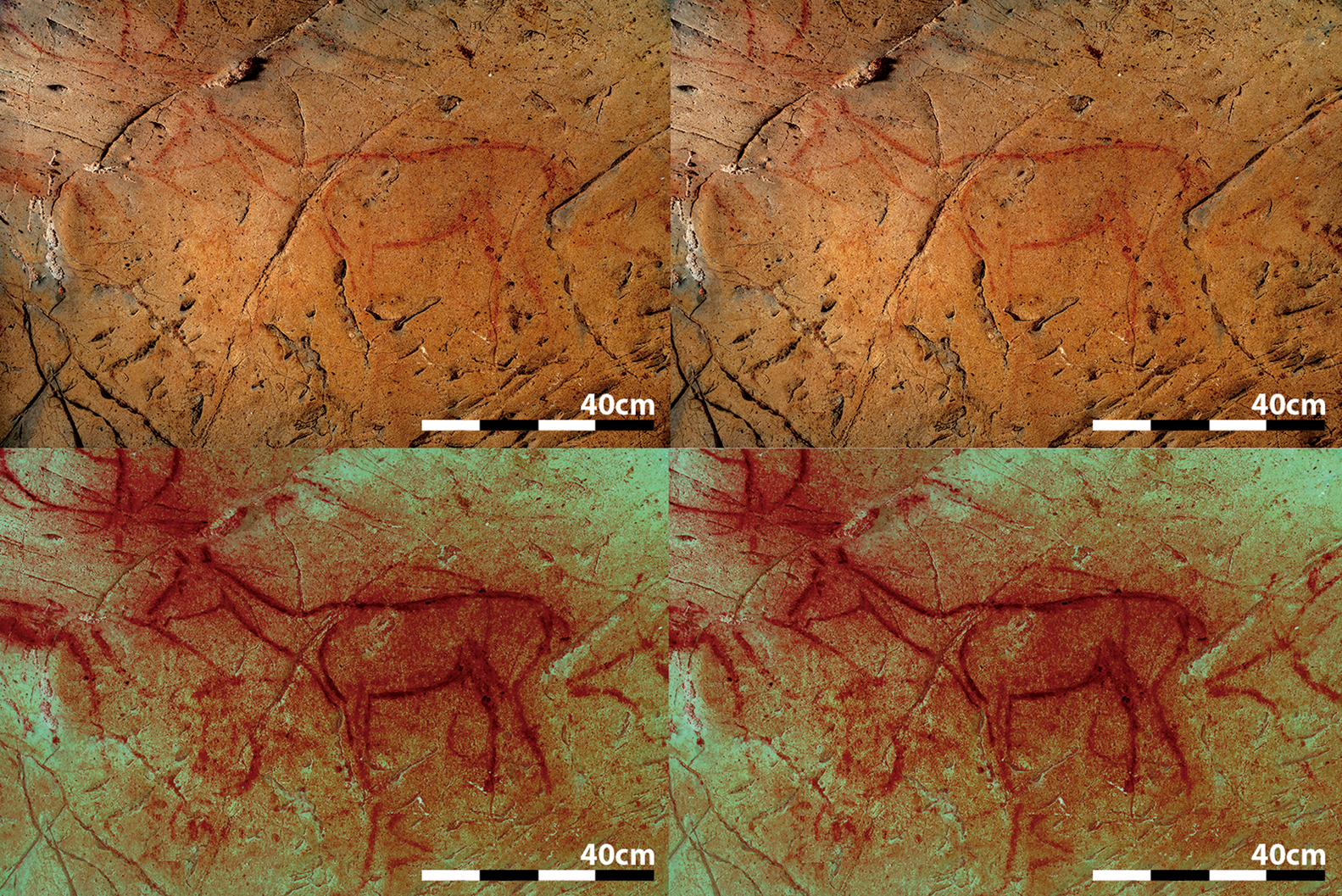
Figure 1. Top: photograph of the area between groups 17 and 18 on the left side of Gallery A; bottom: photograph processed with DStretch (images prepared by R. Asiain & P. Saura). URL for stereo pairs: https://www.flickr.com/gp/196948634@N08/y04FJr872e
The first new figure forms part of group 17. To the right side of this group (which includes the profile of a hind and the head of a possible caprid; not shown here) are some red strokes noted by Breuil et al. (1913: 9). These marks can now be interpreted as a new horse figure: I.A-A.17 (Figure 2). The head, mane, neck and part of the chest are painted in red. The neck and chest are faded making it difficult to perceive the animal without the use of digital image enhancement. The maximum dimensions of the figure are 450 × 400mm. The lines were created with a simple stroke, possibly using a liquid pigment applied with a pad of animal fur. A calcite deposit from the wall encloses the head. The mane and neck are located over a concave depression in the cave wall; conversely, the chest is situated over an area of convex relief, enhancing this area of the animal.
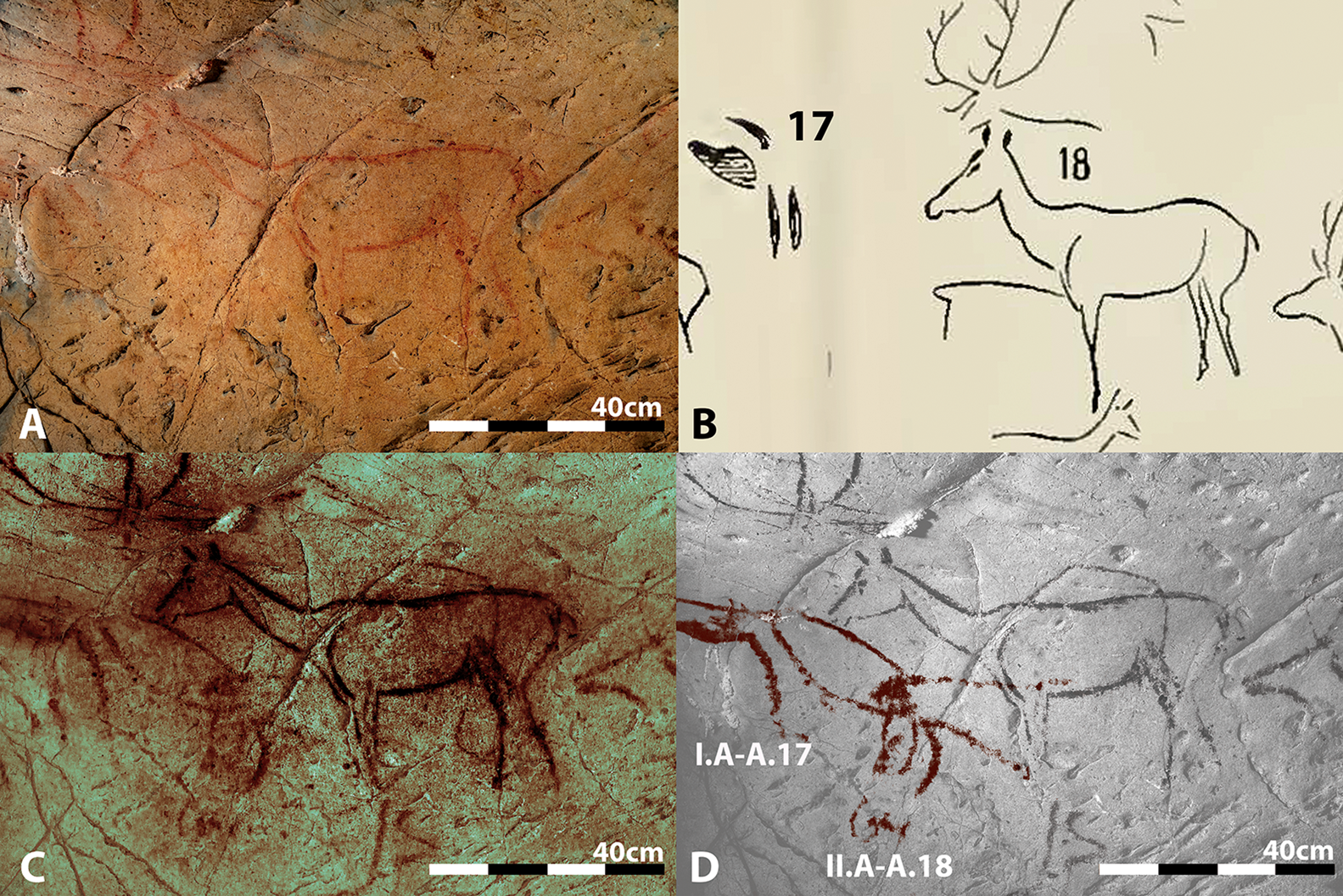
Figure 2. A) area between groups 17 and 18, Gallery A; B) tracing of the same area after Breuil et al. Reference Breuil, Obermaier and Del Río1913; C) the same area processed using DStretch; D) tracing of the same area based on image processed with DStretch (images prepared by R. Asiain & P. Saura).
The second newly identified animal figure is located immediately to the right of I.A-A.17 (Figure 2) and forms part of group 18. This group was previously documented as comprising three figures: a full profile of a deer outlined in red with well-defined antlers; a complete outline in red of a hind, showing many anatomical details, to the right; and an incomplete hind depicted with a faint red line at the bottom of the group. The newly identified figure, II.A-A.18, is located in front of and below the red doe figure in the centre of the group. Previously, this image had been tentatively identified as the badly faded hindquarters of an animal (Breuil et al. Reference Breuil, Obermaier and Del Río1913: 9–10). In this study, we identify this figure as a horse image (Figure 2). Painted in red, the preserved area measures a maximum of 460 × 300mm, depicting the head with the corner of the mouth, an eye, ear and the beginning of the cervico-dorsal line. The horse is depicted using variably spaced dots; on the cervico-dorsal line, the points are more widely spaced, while for the head, they are closely spaced forming a continuous line. The figure makes use of natural features of the cave wall. Cracks in the rock are incorporated into the outlines of the head and chest and the cervical-dorsal line adapts to a concave area.
Still in Gallery A, we have also reinterpreted two well-known figures. The first of these two figures, located in group 5, was previously described by Breuil et al. (Reference Breuil, Obermaier and Del Río1913) as an incomplete horse. In this study, we have reinterpreted this image (here labelled, III.A-A.5) as a complete horse figure by taking into consideration the shape of the cave wall (Figures 3 & 4). The anatomical components of this figure that have been previously described are the head and mane (Breuil et al. Reference Breuil, Obermaier and Del Río1913: 8; González Sainz & Balbín Berhmann Reference González Sainz, De balbín berhmann, Valle and Smith2002). The head is outlined in red using a simple line and the mane depicted with dots. Here, we argue that the cervico-dorsal line, hindquarters and foreleg are suggested by natural lines and edges in the rock surface, with the belly located on an area of convex relief. In this way, these natural formations are combined with the painted components to create a complete animal figure.
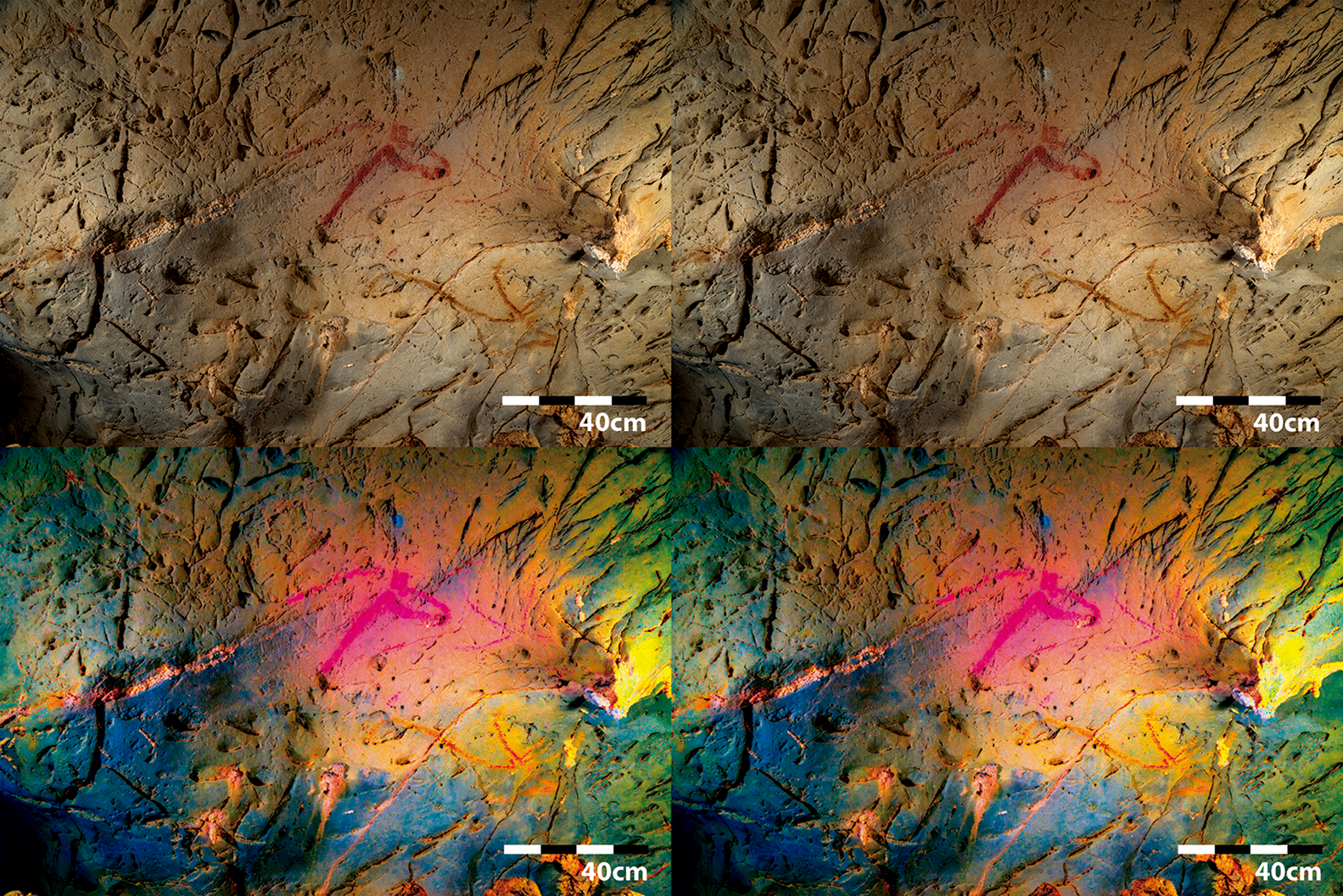
Figure 3. Top: photograph of group 5 on the left side of Gallery A; bottom: photograph processed with DStretch (images prepared by R. Asiain & P. Saura). URL for stereo pairs: https://www.flickr.com/gp/196948634@N08/y04FJr872e
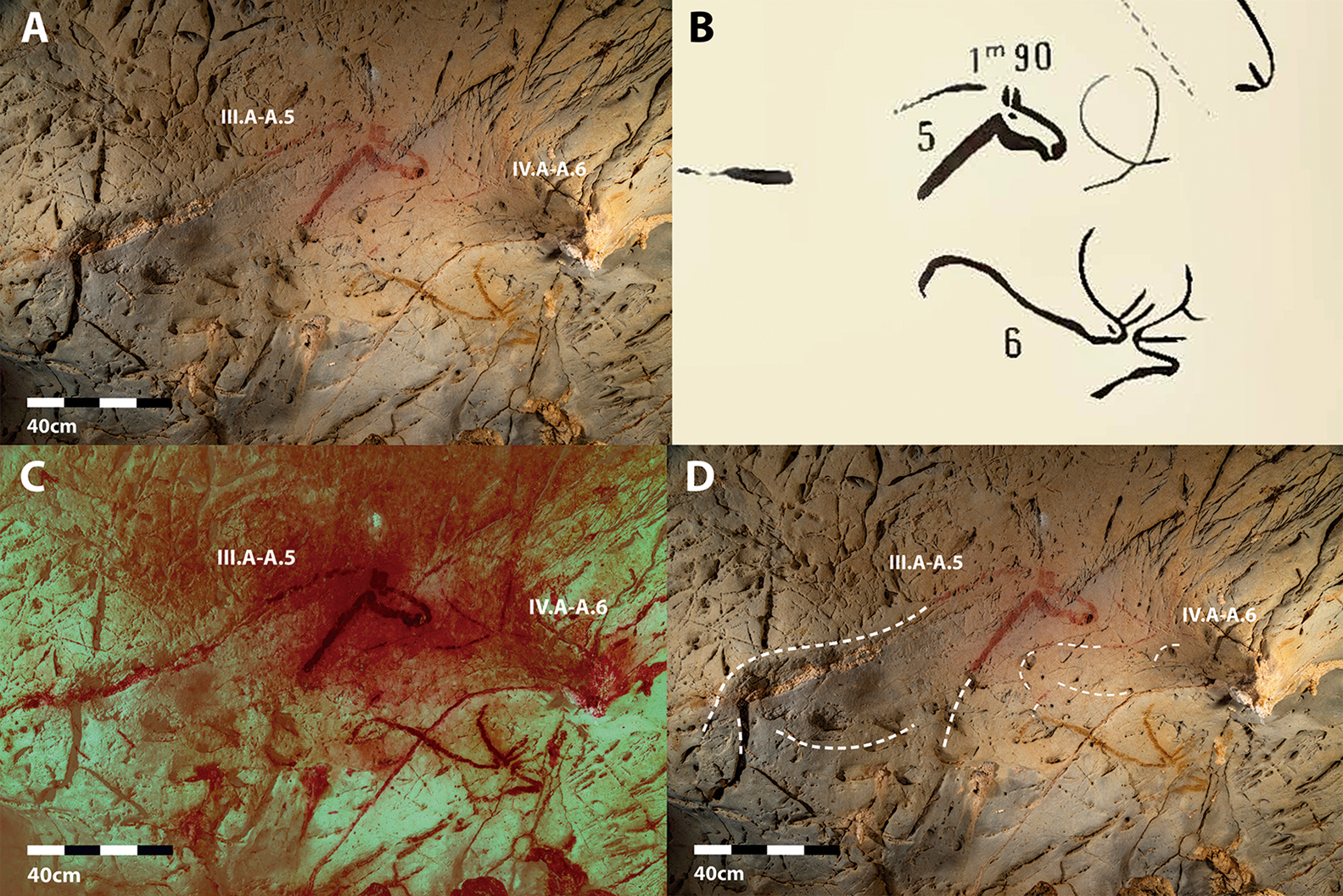
Figure 4. A) Group 5 Gallery A; B) tracing of group 5 after Breuil et al. Reference Breuil, Obermaier and Del Río1913; C) Group 5 processed using DStretch; D) tracing of group 5 by authors (images prepared by R. Asiain & P. Saura).
The second figure in Gallery A that we have reinterpreted is also in Breuil et al.'s (Reference Breuil, Obermaier and Del Río1913) group 5. This figure had previously been interpreted as an incomplete image of a deer (Breuil et al. Reference Breuil, Obermaier and Del Río1913: 8; González Sainz & Balbín Berhmann Reference González Sainz, De balbín berhmann, Valle and Smith2002). Taking into account the natural formations of the cave wall, we reinterpret this as an almost complete deer figure (IV.A-A.6; Figure 4). Painted in dark red, the anatomical parts depicted are the snout, cervico-dorsal line and long curved antlers. The maximum length from the snout to the cervico-dorsal line is approximately 415mm. Here, we suggest that the hindquarters and hind leg of this deer figure are defined by holes and cracks in the rock surface of the cave wall, as are the mandibular area and front part of the neck. Thus, except for the head, natural formations were used to evoke the rest of the deer's figure.
Gallery B
Gallery B contains approximately 200 images, including anthropomorphic and zoomorphic figures of horse, deer, aurochs and bison, as well as various non-figurative dots, stripes and other marks. The images in this gallery are divided into two zones: Gallery B Anterior Zone (panels B.1 to B.8) and Gallery B Posterior Zone (panels B.9 to B.12; Balbín Berhmann & González Sainz Reference Balbín Berhmann and González-Sainz1993). Panel B.2 is located close to the original entrance of the (currently sealed) gallery and features two images of large bovines associated with a non-figurative depiction and various incised figures. Based on stylistic grounds, panel B.2 has been assigned to the early Style IV (Middle Magdalenian; Leroi-Gourhan Reference Leroi-Gourhan1965, Reference Leroi-Gourhan1983; Balbín Berhmann & González Sainz Reference Balbín Berhmann and González-Sainz1993, Reference Balbín Berhmann and González-Sainz1995, Reference Balbín Berhmann, González-Sainz and Moure1996; González Sainz & Balbín Berhmann Reference González Sainz, De Balbín Berhmann and Ontañón2000, Reference González Sainz, De balbín berhmann, Valle and Smith2002). We have identified a previously unrecognised figure in group 54 of panel B.2. Group 54 includes a large bison positioned on a red painted line, previously interpreted as a possible ‘ground line’ (Breuil et al. Reference Breuil, Obermaier and Del Río1913: 17–18). Here, we reinterpret this ground line as a new figure, depicting a large bovid, possibly an aurochs (V.B-B.54; Figure 5).
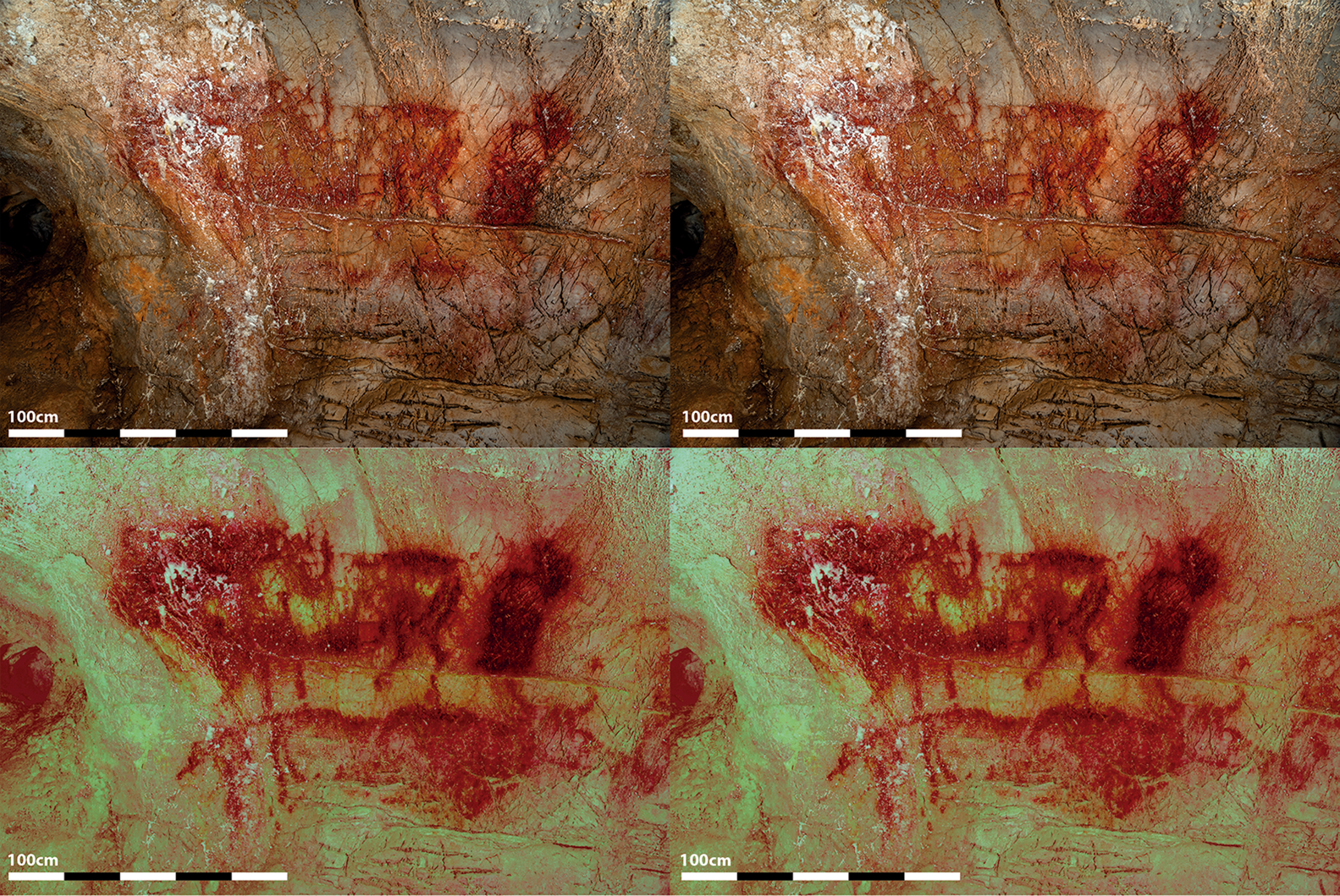
Figure 5. Top: photograph of group 54 (Panel B.2, Gallery B); bottom: photograph processed using DStretch (images prepared by R. Asiain & P. Saura). URL for stereo pairs: https://www.flickr.com/gp/196948634@N08/y04FJr872e
The maximum dimensions of the figure are 1650 × 700mm. The anatomical elements depicted are the lyre-shaped horns, head, cervico-dorsal line, hindquarters, tail, the start of the hind leg, belly, foreleg and chest. The outline of the animal is drawn with a delicate stroke. Some traces of red pigment that presumably filled the entire figure can still be discerned. The antlers, shoulder hump and hindquarters incorporate areas of convex rock, the dorso-lumbar line adapts to the surface of the wall, the hind leg includes a rock edge into the paint stroke, and the belly and chest incorporate the cracks in the rock surface to define these anatomical parts (Figure 6).
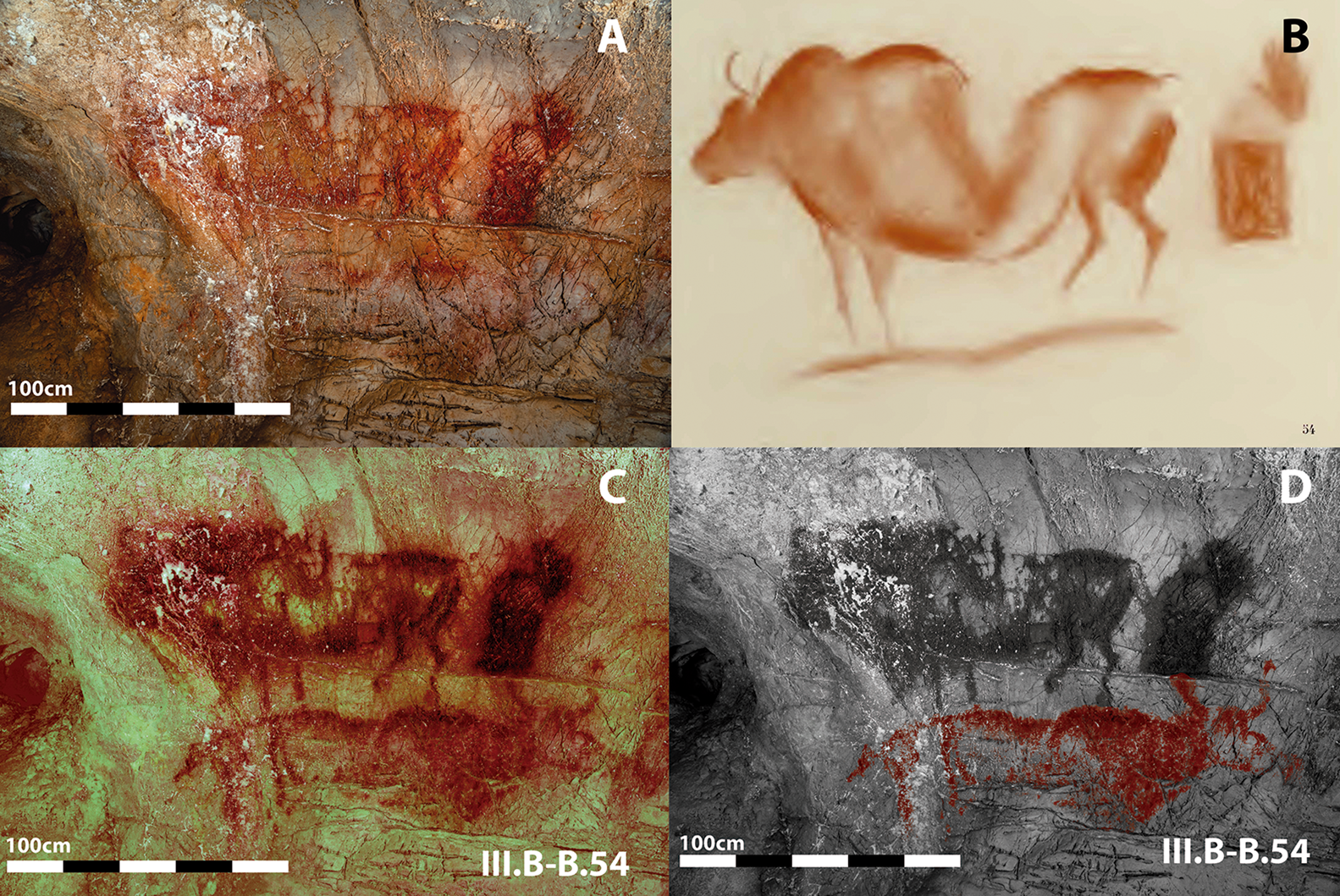
Figure 6. A) Group 54 Gallery B; B) tracing of group 54 after Breuil et al. Reference Breuil, Obermaier and Del Río1913; C) Group 54 processed using DStretch; D) tracing of group 54 by authors (images prepared by R. Asiain & P. Saura).
Zone D
In the central part of the cave complex, Zone D has fewer and more scattered images compared with the other three galleries. The images in this zone also demonstrate more technical and stylistic variety. The main corridor of Zone D leads to two ‘rooms’, one on top of the other. In the 1950s, two painted horse figures were discovered on the ceiling of the upper room, both assigned on stylistic grounds to the advanced Style III (Lower Magdalenian; Reference González Echegaray and RipollGonzález Echegaray & Ripoll 1953/54; González Sainz & Balbín Berhmann Reference González Sainz, De balbín berhmann, Valle and Smith2002). Here, we reinterpret the incomplete figure of horse 5 in Gallery D, showing how the natural features of the rock surface permit the identification of a complete horse figure (VI.D-D.5; Figure 7).
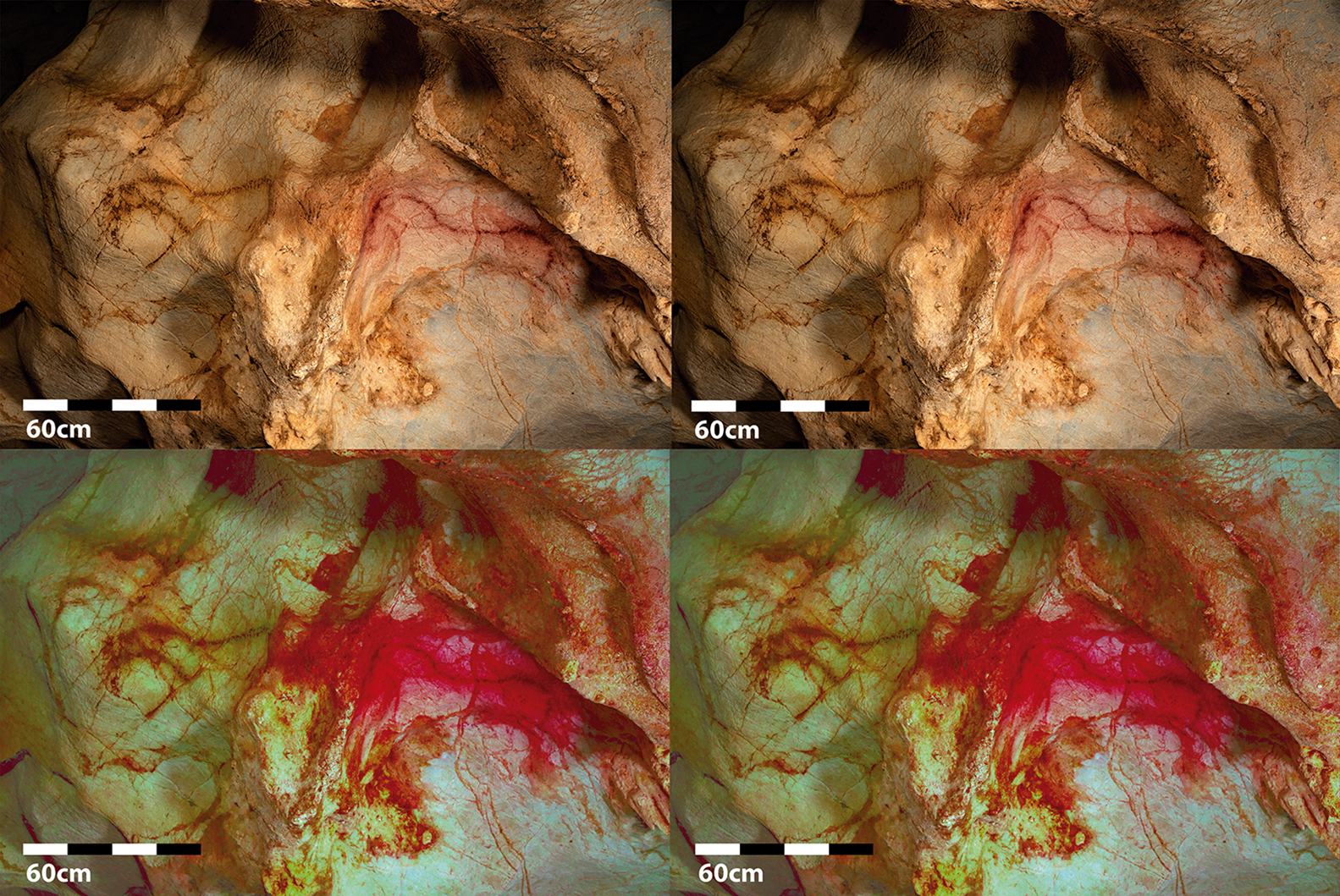
Figure 7. Top: photograph of horse 5, left (VI.D-D.5) in Gallery D; bottom: photograph processed using DStretch (images prepared by R. Asiain & P. Saura). URL for stereo pairs: https://www.flickr.com/gp/196948634@N08/y04FJr872e
The horse is painted in yellow ochre, with a maximum length from head to hindquarters of 600mm. The anatomical parts previously identified are the head, mane, cervico-dorsal line and hindquarters (Reference González Echegaray and RipollGonzález Echegaray & Ripoll 1953/54: 61). Taking into consideration the shape of the rock surface, we suggest that a natural rock edge defines the belly of this horse; the natural cracks of the rock also define the foreleg (Figure 8). Without the use of paint, therefore, these anatomical elements are evoked by the natural rock surface.
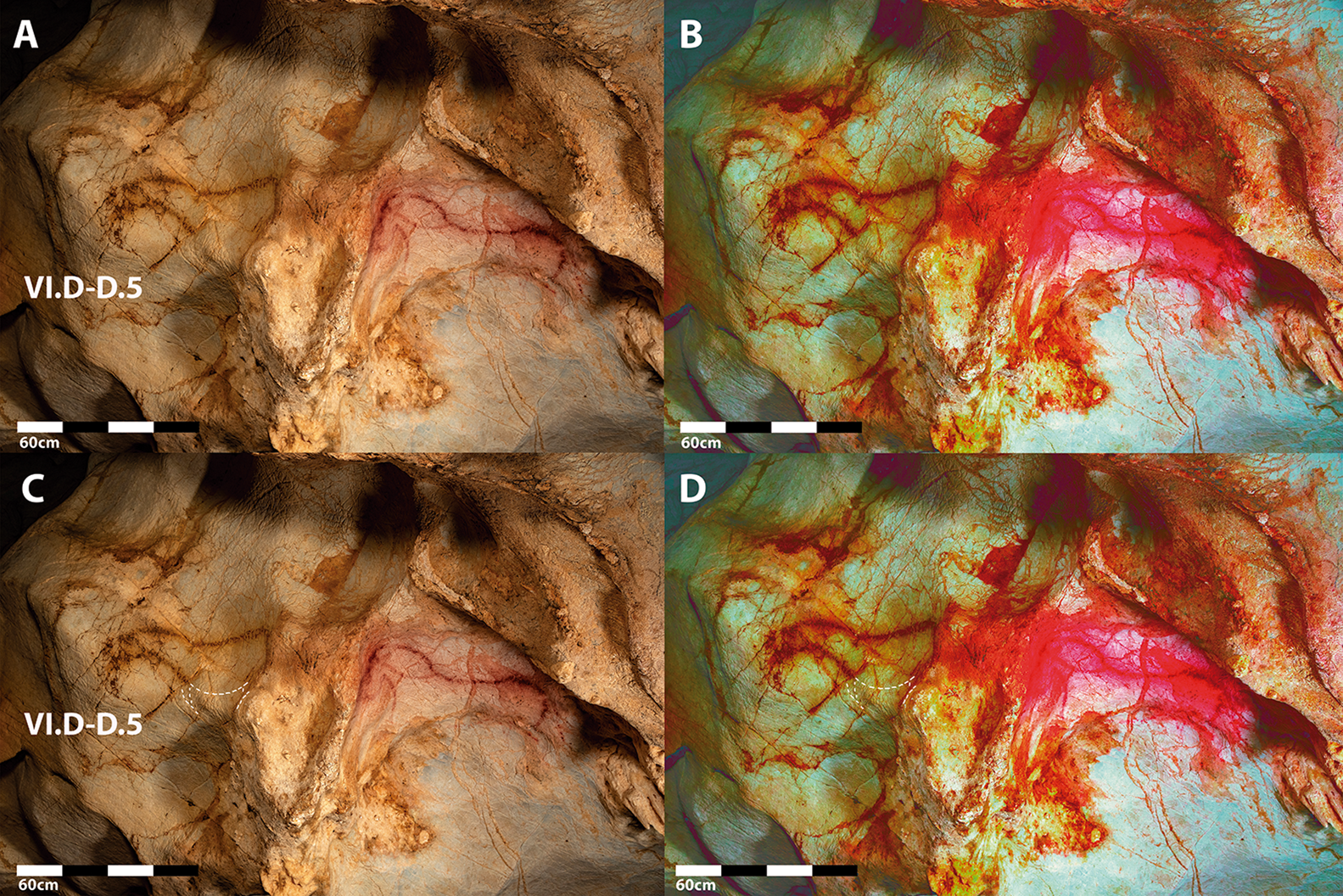
Figure 8. A) tracing of new anatomical elements of horse figure 5 (Gallery D) by authors; B) image processed using DStretch and tracing of new anatomical parts of horse figure 5 by authors (images prepared by R. Asiain & P. Saura). URL for stereo pairs: https://www.flickr.com/gp/196948634@N08/y04FJr872e
New figures, new perspectives
In Gallery A, five animal species are represented. As is usual in Cantabrian art, horse and deer stand out (De las Heras Reference De Las Heras Martín1994; Garate 2007). This association of deer with other animals, such as horses, is also characteristic of nearby caves such as Arenaza, Covalanas or El Pendo (González Sainz Reference González Sainz2004). The two new horse figures (I.A-A.17 and II.A-A.18) identified in Gallery A reinforce this thematic association via proximity to the deer figures of groups 17 and 18. The newly identified horse (I.A-A.17), is depicted with a simple red line. Among the horse figures in Gallery A, lines predominate over detail (De las Heras Martín Reference De Las Heras Martín1994: 289). This type of painted line, thin or thick, is one of the most widely used techniques in this gallery. The depiction of I.A-A.17 shows some stylistic and technical similarities with the horse figures of groups 30 and 34 (Figure 9). The group 34 horse has a narrow neck and a mane depicted with a curved line; these stylistic features are also found in I.A-A.17. Further, I.A-A.17 and the other two horse figures from groups 30 and 34 all incorporate natural rock formations of the cave walls into the painted images. In all three figures, the neck and mane are adapted to areas of concave relief and the chest area located on convex relief.
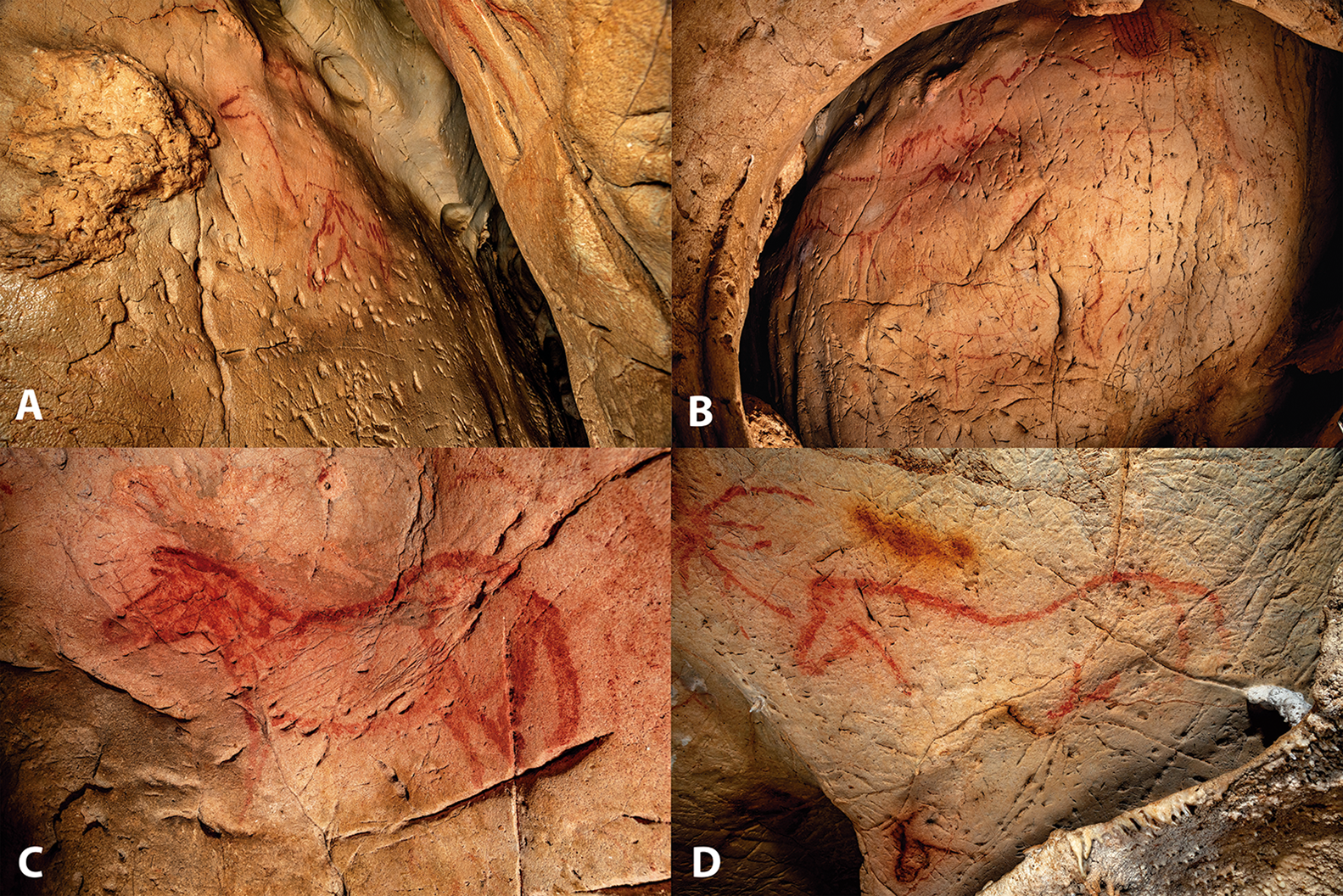
Figure 9. Depictions of horses in Gallery A: A) group 30; B) group 34; C) group 25; D) group 44 (images prepared by R. Asiain & P. Saura).
In Gallery A, some of the animal figures are painted using lines of dots, sometimes so closely spaced as to create continuous lines. Three animal figures depicted in this way have been attributed to the same possible hand: the ‘Maître aux Contours expressionnistes’ (Groenen & Martens Reference Groenen and Martens2010: 16–17). Two of these three figures (horses from groups 30 and 34) are mentioned above; the third figure is the bovid 35 (Breuil et al. Reference Breuil, Obermaier and Del Río1913: 13–14). These images share some characteristics, including the concave snout (or muzzle) profile, similar to an elk, and the mane depicted by isolated strokes. The new horse figure, II.A-A.18, features a muzzle depicted in a similar way to the more significant red horse figure in group 25 (Breuil et al. Reference Breuil, Obermaier and Del Río1913: 11) and a mane like that in horse figure 44 (Breuil et al. Reference Breuil, Obermaier and Del Río1913: 16), both also attributed to the ‘Maître aux Contours expressionnistes’. These figures, made with dots and continuous lines, including II.A-A.18, tend to be partial depictions of animals and are characteristic of Gallery A (De las Heras Martín Reference De Las Heras Martín1994: 291).
The incorporation of irregularities of the rock surface into the II.A-A.18 is similar to the horses 16, 34 and 44 (Breuil et al. Reference Breuil, Obermaier and Del Río1913), all in Gallery A. In all five cases, the neck and cervical-dorsal lines are adapted to areas of concave relief. In addition, horses 25 and 44, and II.A-A.18 incorporate cracks in the cave wall using paint strokes to define the animal's chest. Based on these technical, stylistic and formal similarities with the figures made by the ‘Maître aux Contours expressionnistes’ in Gallery A, II.A-A.18 might also be assigned to this hand.
The final unpublished figure identified here, a possible aurochs labelled V.B-B.54, forms part of panel B.2 of Gallery B alongside two other bovid figures: bison 54 and aurochs 55. The lengths of bison 54 and aurochs 55 are 1.3m and 1.65m respectively (Figure 10). The size of the latter is equal to that of the new aurochs V.B-B.54 on the same panel. These two figures share other artistic conventions, such as the drawing of the shoulder hump, the back-lumbar line, the hindquarters and the belly. In addition, both animals are depicted from a similar perspective, represented in profile with the horns pointing forward. According to the traditional schemes of Breuil (Reference Breuil1952) and Leroi-Gourhan (Reference Leroi-Gourhan1983), this perspective is defined as ‘perspective tordue’ or ‘perspective bi-angular droite’ respectively, and associated with older phases (Style II, according to Leroi-Gourhan), contrasting with other technical characteristics typical of the Magdalenian period, such as outline engraving. With the discovery of the new aurochs figure V.B-B.54, the panel now presents a composition of four images: a sign (54) at the top of the panel, aurochs 55 facing right, bison 54 facing left, and V.B-B.54, below the bison 54, also facing left. With the addition of the new aurochs figure, the group depicted in this panel could be interpreted as a possible ‘scene’ or ‘group portrait’ (Figure 10).
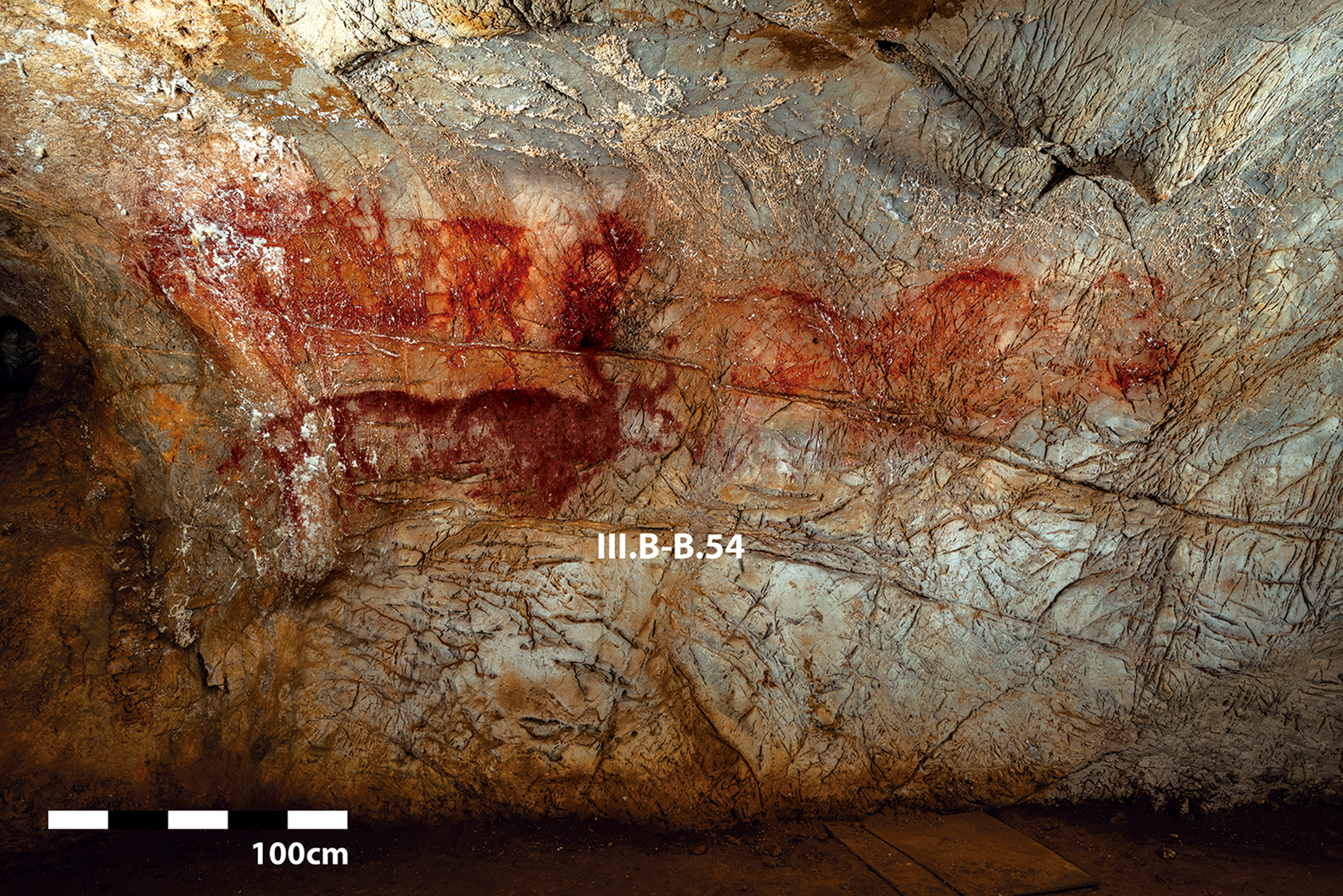
Figure 10. Panel B.2 in Gallery B showing group of animals including Figure III.B-B.54 digitally highlighted (images prepared by R. Asiain & P. Saura).
The existence and interpretation of scenes in Palaeolithic parietal and portable art is much debated (Fritz & Tosello Reference Fritz and Tosello2007; Bahn Reference Bahn2016; Davidson Reference Davidson, Davidson and Nowell2021). Despite the frequent depiction of groups of large mammals, few of these examples have been characterised as scenes (Guthrie Reference Guthrie2005: 61). Panel B.2 does not correspond to the definition of a scene as a “representation of an action” (Villaverde Reference Villaverde, Davidson and Nowell2021), typical of hunting scenes in Levantine art, but here we propose to consider it as a portrait of a group of mammals. According to Guthrie (Reference Guthrie2005: 61), if the animals that appear grouped more frequently in such panels are, today, social animals, these images could be interpreted in the sense of ‘group portraits’. Indeed, other researchers (e.g. Davidson Reference Davidson, Davidson and Nowell2021: 18) argue that the absence of scenes in Palaeolithic art is due, in large part, to a misinterpretation of these images.
Regarding the use of natural rock formations to define or enhance animal figures, aurochs V.B-B.54 shares many similarities with aurochs 55. The horns, shoulder hump and hindquarters of both figures take advantage of areas of convex relief on the cave walls, while the chest and belly incorporate the cracks in the wall into the paint strokes. The use of the natural irregularities of cave walls to represent anatomical parts is found more widely at La Pasiega and adds to the list of other examples where the incorporation of natural characteristics of cave walls might be considered as an artistic technique on a par with painting or engraving (Lejeune Reference Lejeune1985; Corchón Reference Corchón1986; Sauvet & Tosello Reference Sauvet, Tosello, Sacco and Sauvet1998; Múzquiz & Saura Reference Múzquiz Pérez-Seoane, Saura and Lasheras2002; Groenen & Clottes Reference Groenen and Clottes2016). With this study (Asiain Reference Asiain2021), we strengthen this idea and advance its potential use as a complementary tool for stylistic interpretations.
We have also reinterpreted three other figures in Gallery A and Zone D where images have made use of natural rock formations. These figures, II.A-A.18 and III.A-A.5 in Gallery A, and VI.D-D.5 in Zone D, were previously considered incomplete; here, by taking into account the use of natural rock features, we have reinterpreted these as complete animal figures. A shared characteristic of these examples is that the anatomical elements evoked with natural formations, especially rock edges, are the hindquarters and ventral regions of the animals.
Conclusions
Using new digital stereoscopic recording methods, we have revisited the rock art of La Pasiega cave, identifying previously unrecognised animal figures and reinterpreting other figures thought previously to be incomplete. Stereoscopic photographs have allowed us to recognise correlations between images and irregularities of the rock walls of the cave, which are not perceptible in two-dimensional photographs. Further, we have shown that the identification of the use of the natural rock surface to define animal figures can complement the analysis of cultural processes, styles and even the possible authorship of individual images (Groenen & Martens Reference Groenen and Martens2010; Fritz & Tosello 2015). The incorporation of natural rock features into palaeolithic depictions clearly reflects something typical of the Ice Age parietal art (Bahn Reference Bahn2016: 160). Regarding that idea, several scholars have previously stated that understanding Palaeolithic cave art is impossible without consideration of the rock surfaces on which it was created (Sauvet & Tosello 1993; Groenen & Clottes Reference Groenen and Clottes2016); here, we have used stereoscopic photography as a practical method of achieving this. La Pasiega cave provides a good example of a site where previous research relied on the description of the art based on colour, form and painting or engraving technique, with the natural rock surfaces only occasionally acknowledged. Going forward it will be essential to document both elements to ensure the full recognition and proper interpretation of such cave art. To conclude, Palaeolithic rock art should not be defined only by drawn, painted or engraved marks but also by the topographical features of the rock on which they are inscribed—the two elements cannot be separated.
Acknowledgements
This work is part of the results of Raquel Asiain's PhD thesis under the supervision of Pedro Saura at the Faculty of Fine Arts of the Complutense University of Madrid. The authors would also like to thank Juan Luis Arsuaga, chair of the UCM-ISCIII (Universidad Complutense of Madrid and the Human Evolution and Behavior Institute) Mixed Center, for his help and time working on this article.
Funding statement
The authors thank the Complutense University of Madrid, which funded the PhD fellowship (CT17/17-CT18/17), and the Consejería de Universidades, Igualdad, Cultura y Deporte del Gobierno de Cantabria, for providing access to the cave of La Pasiega.















